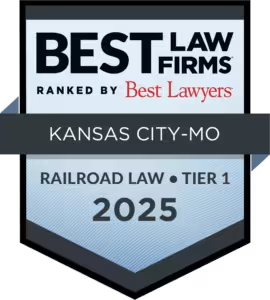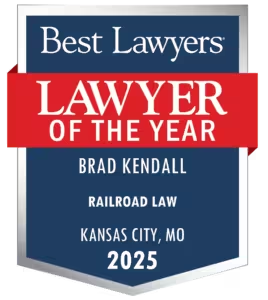Kendall Law Group LLC
Skilled Railroad Accident Injury Trial Lawyers in Kansas City, Missouri
Here to Help You Put Your Life Back Together
Experienced. Knowledgeable. Aggressive.
Compassionate Guidance
When You Need It Most
Railroad accidents can lead to life-altering consequences for workers, passengers, motorists and bystanders. When negligence causes harm – whether due to faulty equipment, unsafe conditions or operational errors – victims deserve justice and fair compensation. The skilled Kansas City railroad accident injury trial lawyers of Kendall Law Group are dedicated to holding railroad companies accountable and advocating for those seriously injured by their negligence.
Why are Railroad Accidents So Severe?
Railroad accidents often result in catastrophic damage and significant risks to life due to a combination of factors inherent to train operation and infrastructure. Here are a few primary reasons why these incidents can be so devastating:
- Massive Weight and Momentum: Trains can weigh thousands of tons. Once in motion, their immense momentum makes it nearly impossible to stop quickly, even in emergencies. This contributes to the severity of collisions, as vehicles or pedestrians involved have little chance to avoid or withstand the impact.
- High Speeds: In rural or less populated areas, trains often travel at high speeds. The kinetic energy from high-speed impacts can amplify the damage, leading to catastrophic injuries or fatalities.
- Size Disparity: Trains dwarf vehicles, pedestrians, or other obstacles. In collisions, the smaller party bears the brunt of the damage, often with devastating consequences.
- Limited Ability to Maneuver: Unlike vehicles, trains are confined to tracks. They cannot swerve to avoid an obstacle, meaning any hazard on the tracks almost guarantees a collision.
- Delayed Reaction Time: Even with advanced safety systems, train operators may not have enough time to see and react to obstacles, especially at higher speeds. This delay increases the likelihood of accidents.
- Aging Infrastructure and Equipment: Poorly maintained tracks, signals, and crossing gates increase the risk of derailments and other accidents. Similarly, aging or malfunctioning train equipment can contribute to mechanical failures with catastrophic outcomes.
- Passive Crossings: Passive crossings are railroad intersections without gates, lights, or alarms—are particularly hazardous. They rely entirely on drivers or pedestrians to notice approaching trains, often leading to deadly misjudgments.
- Human Error: Operator or pedestrian mistakes, such as ignoring signals or trespassing on tracks, are common causes of accidents. These errors can result in devastating consequences.
- Chain Reactions: Collisions involving trains and vehicles often trigger chain reactions, causing damage to nearby structures, additional vehicles, or the train itself. Derailments can lead to widespread destruction, affecting entire communities.
- Limited Emergency Access: When accidents occur in remote or rural areas, emergency responders may face delays in reaching the scene. These delays can worsen outcomes for victims and complicate rescue efforts.
The combination of these factors highlights the critical need for robust railroad safety systems, public awareness and maintenance of infrastructure to prevent accidents. When railroad negligence plays a role in these incidents, victims may have legal recourse to seek compensation for their injuries and losses.
Types of Railroad Accidents Involving Negligence
Train Derailments
A train derailment occurs when one or more train cars come off the tracks. Derailments can range from minor incidents, where only a single wheel leaves the rail to catastrophic events, where multiple cars overturn, potentially leading to loss of life, injuries or environmental changes.
Train derailments in Kansas and Missouri are typically caused by a combination of human, environmental and mechanical factors. The states’ geographical features and transportation infrastructure also play a role. Primary causes of train derailments include:
- Track Conditions
- Poor Maintenance: Deteriorated or misaligned tracks are a leading cause of derailments in Kansas and Missouri.
- Heat-Induced Rail Buckling: Kansas and Missouri experience significant temperature fluctuations, which can cause rails to expand, warp or buckle.
- Switch Failure: Improperly set or malfunctioning track switches can lead to derailments.
- Human Error
- Operator Mistakes: Errors in speed control, braking or misjudging track conditions can cause derailments.
- Signal Miscommunication: Misunderstandings between train operators and dispatchers can lead to collisions or derailments.
- Equipment Failures
- Wheel or Axle Defects: Damaged wheels or axles can cause a train to jump the track.
- Braking Issues: Faulty braking systems can lead to runaway trains or derailments during turns or stops.
- Coupling Failures: Improperly coupled train cars can separate and cause derailments.
- Collisions
Vehicle Train Collisions: Kansas and Missouri have numerous passive crossings (crossings without gates or lights), which increase the likelihood of vehicles or farm equipment being struck, causing derailments.
- Heavy Freight Overloading
- Weight Imbalances: Kansas and Missouri are central hubs for freight trains carrying agricultural products, oil and hazardous materials. Overloaded or improperly loaded train cars can destabilize a train.
- Excessive Speed: Traveling too fast for the weight or conditions of the train can lead to derailments, especially on curves.
- Crossing and Grade Issues
- Steep Grades: In rural areas, crossings with steep grades can increase the risk of derailment, especially if vehicles become stuck or the crossing is not properly maintained.
- Obstructed Views: Overgrown vegetation or structures blocking views at crossings can lead to accidents involving vehicles or obstacles on the tracks.
- Aging Infrastructure
Both Kansas and Missouri have a mix of modern and aging rail infrastructure. Deferred maintenance on older tracks and bridges increases derailment risks.
Railroad Crossing Accidents
Railroad crossing accidents occur when vehicles, pedestrians or cyclists collide with a train at a railroad crossing. These intersections – where railroads meet roadways – are particularly hazardous when safety measures are inadequate.
Railroad crossing accidents are especially concerning in Kansas in Missouri, where extensive rail networks intersect with urban and rural roadways. The severity of these accidents often results from the size, weight and speed of trains, combined with limited warning systems or poor crossing infrastructure.
Common causes of railroad crossing accidents in Kansas and Missouri include:
- Malfunctioning Signals and Gates: Defective crossing gates that fail to lower properly and/or inoperative flashing lights or alarms that do not warn of an approaching train.
- Passive Crossings: Many crossings in rural areas lack active warning systems like lights or gates. These “passive crossings” rely solely on static signs such as crossbucks or stop signs, increasing the likelihood of a driver or pedestrian oversight.
- Obstructed Views: Overgrown vegetation can block the view of approaching trains, making it difficult for drivers or pedestrians to assess the crossing’s safety.
- Train Operator Errors: Failing to sound the horn in time to warn motorists or pedestrians of an oncoming train and/or inadequate adherence to speed regulations in high-traffic areas.
- Poorly Maintained Crossings: Uneven or deteriorated road surfaces at crossings can cause vehicles to stall or slow down dangerously.
- Limited Visibility at Night or in Poor Weather: Insufficient lighting or inclement weather can obscure warning signals and approaching locomotives.
Both Kansas and Missouri have numerous rural crossings without active warning systems. These passive crossings are particularly dangerous because they depend on drivers and pedestrians to recognize the risks, often without adequate visibility or signage. In cities like Kansas City, the high volume of train traffic creates additional risks at heavily trafficked crossings. Malfunctioning gates or misjudgments by drivers navigating busy roads can be catastrophic. Both states have significant freight rail operations, meaning crossings are frequently active, increasing the risk of collisions at poorly maintained or equipped intersections.
Passenger Injuries
In Kansas and Missouri, passenger rail services are primarily provided by Amtrack, the national passenger railroad service. Historically, Amtrak has been involved in several significant accidents in Kansas and Missouri including:
1979 Lawrence, Kansas Derailment. On October 2, 1979, the Southwest Limited derailed due to excessive speed on a curve near Lawrence, resulting in two fatalities and sixty-nine injuries.
2016 Cimarron, Kansas Derailment. On March 14, 2016, the Southwest Chief derailed approximately 20 miles west of Dodge City, near Cimarron, resulting in twenty-eight injuries. This derailment was by a feed truck that had inadvertently damaged the tracks.
Worker Injuries (FELA Claims)
Railroad worker injuries fall under the Federal Employers’ Liability Act (FELA), a U.S. law enacted in 1908 to protect railroad workers injured on the job. Unlike workers’ compensation, FELA requires workers to prove negligence by the railroad or its employees to recover damages.
Under FELA, a railroad worker injured through negligence can claim compensation for medical expenses, lost wages (past and future), pain and suffering, emotional distress and loss of earning capacity.
Primary Causes of Railroad Worker Injuries in Kansas City
- Unsafe Working Conditions
- Poorly maintained tracks, tools or equipment
- Lack of protective gear or safety protocols
- Heavy Equipment and Machinery
- Malfunctioning equipment can cause crush injuries or amputations.
- Collisions and Derailments
- Workers involved in train operations face risks of accidents due to operator error, signal failure or infrastructure issues.
- Inadequate Training
- Workers may not receive proper training for their roles, increasing the likelihood of mistakes and injuries.
- Defective Equipment
- Broken tools, faulty railcars or poorly maintained locomotives contribute to workplace injuries.
Hazardous Material Accidents
A hazardous material railroad accident involves the unintentional release of dangerous substances during rail transport, posing significant risks to public health, safety and the environment. Such incidents can lead to fires, explosions, toxic exposures and environmental contamination.
Causes in Kansas and Missouri
- Derailments: Trains carrying hazardous materials can derail due to track defects, equipment failures or collisions. For instance, in March 2023, a Union Pacific train derailed in McPherson, Kansas, spilling denatured alcohol. The suspected cause was a broken wheel.
- Grade Crossing Collisions: Accidents at railroad crossings, especially those lacking active warning systems, can result in collisions between trains and vehicles.
- Track and Equipment Failures: Defective tracks, broken rails or malfunctioning equipment can cause accidents.
- Human Factors: Operator errors, such as misinterpreting signals or failing to adhere to safety protocols, can lead to accidents as well as fatigue and inadequate training.
Common Injuries in Railroad Negligence Cases
Railroad accidents can inflict devastating injuries, including but not limited to:
- Traumatic Brain Injuries (TBIs): Often resulting in long-term cognitive or physical impairments.
- Spinal Cord Injuries: Leading to paralysis or mobility challenges.
- Amputations and Crush Injuries: Typically, from collisions or machinery incidents.
- Severe Burns: From fires or chemical spills during accidents.
- Internal Organ Damage: Often requiring extensive medical care.
- Psychological Trauma: Many victims suffer PTSD and other mental health challenges.
Why Victims Turn to Kendall Law Group LLC for Railroad Negligence Cases
Strong Advocacy and Case Results
- Achieved the highest FELA verdict on record in Kansas City, MO.
- Extensive success across various types of railroad negligence cases.
Skilled Representation in Railroad Law
We represent:
- Railroad workers covered under FELA.
- Injured passengers, motorists, and bystanders.
- Families seeking justice for wrongful deaths caused by railroad negligence.
Client-Focused Legal Support
- Personalized attention to every case.
- Transparent communication to guide you through the legal process.
- Determined advocacy to secure the compensation you deserve.
What Can You Recover in a Railroad Negligence Case?
Victims of railroad negligence may be eligible for compensation, including:
- Medical Costs: Coverage for immediate and long-term care.
- Lost Income: Including diminished earning potential.
- Pain and Suffering: Acknowledgment of physical and emotional distress.
- Property Damage: Including vehicle repairs for crossing accidents.
- Wrongful Death Damages: Support for grieving families.
Our Process for Handling Railroad Negligence Cases
- Free Case Evaluation: Share your story with us during a no-cost consultation.
- Thorough Investigation: We gather crucial evidence, including:
- Maintenance logs.
- Accident reports.
- Eyewitness statements.
- Strategic Case Building: Collaborating with industry professionals to identify all liable parties.
- Aggressive Advocacy: From negotiating settlements to litigating in court, we fight to achieve fair outcomes for our clients.
Kansas City Train Accident Injury Trial Lawyers
Railroad companies act swiftly to protect their interests after an accident. If you are seriously injured in a railroad accident, you need a skilled trial team by your side. Contact Kendall Law Group as soon as possible to discuss your case. Give us a call at (816) 531-3100 or reach out HERE.
For more information on railroad accidents, read the following attorney blogs:
Uncontrolled Railroad Crossings Pose Dangers Across the US



